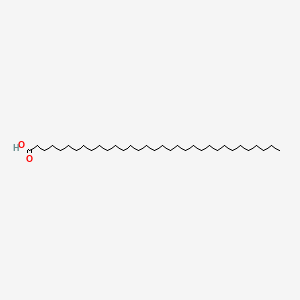| MeSH term | MeSH ID | Detail |
|---|---|---|
| Body Weight | D001835 | 333 associated lipids |
| Hypercholesterolemia | D006937 | 91 associated lipids |
| Diabetes Mellitus, Type 2 | D003924 | 87 associated lipids |
tritriacontanoic acid
tritriacontanoic acid is a lipid of Fatty Acyls (FA) class. Tritriacontanoic acid is associated with abnormalities such as hypercholesterolemia, Metabolic syndrome, Diabetes Mellitus, Non-Insulin-Dependent, Diabetes Mellitus, Insulin-Dependent and Parkinson Disease. The involved functions are known as Fermentation, Process, Longterm Effects, Pressure- physical agent and Lipid Metabolism. Tritriacontanoic acid often locates in Blood, Tissue fiber and A Fibers. The associated genes with tritriacontanoic acid are STN gene. The related lipids are Total cholesterol and blood lipid.
Cross Reference
Introduction
To understand associated biological information of tritriacontanoic acid, we collected biological information of abnormalities, associated pathways, cellular/molecular locations, biological functions, related genes/proteins, lipids and common seen animal/experimental models with organized paragraphs from literatures.
What diseases are associated with tritriacontanoic acid?
tritriacontanoic acid is suspected in hypercholesterolemia, Metabolic syndrome, Diabetes Mellitus, Non-Insulin-Dependent, Diabetes Mellitus, Insulin-Dependent, Parkinson Disease and other diseases in descending order of the highest number of associated sentences.
Related references are mostly published in these journals:
| Disease | Cross reference | Weighted score | Related literature |
|---|
Possible diseases from mapped MeSH terms on references
We collected disease MeSH terms mapped to the references associated with tritriacontanoic acid
PubChem Associated disorders and diseases
What pathways are associated with tritriacontanoic acid
There are no associated biomedical information in the current reference collection.
PubChem Biomolecular Interactions and Pathways
Link to PubChem Biomolecular Interactions and PathwaysWhat cellular locations are associated with tritriacontanoic acid?
Visualization in cellular structure
Associated locations are in red color. Not associated locations are in black.
Related references are published most in these journals:
| Location | Cross reference | Weighted score | Related literatures |
|---|
What functions are associated with tritriacontanoic acid?
Related references are published most in these journals:
| Function | Cross reference | Weighted score | Related literatures |
|---|
What lipids are associated with tritriacontanoic acid?
Related references are published most in these journals:
| Lipid concept | Cross reference | Weighted score | Related literatures |
|---|
What genes are associated with tritriacontanoic acid?
Related references are published most in these journals:
| Gene | Cross reference | Weighted score | Related literatures |
|---|
What common seen animal models are associated with tritriacontanoic acid?
There are no associated biomedical information in the current reference collection.
NCBI Entrez Crosslinks
All references with tritriacontanoic acid
Download all related citations| Authors | Title | Published | Journal | PubMed Link |
|---|---|---|---|---|
| GarcÃa JJ et al. | Influence of two dietary fibers in the oral bioavailability and other pharmacokinetic parameters of ethinyloestradiol. | 2000 | Contraception | pmid:11172796 |
| Marlett JA et al. | An unfermented gel component of psyllium seed husk promotes laxation as a lubricant in humans. | 2000 | Am. J. Clin. Nutr. | pmid:10966900 |
| Ho YH et al. | Micronized purified flavonidic fraction compared favorably with rubber band ligation and fiber alone in the management of bleeding hemorrhoids: randomized controlled trial. | 2000 | Dis. Colon Rectum | pmid:10813126 |
| Bonithon-Kopp C et al. | Calcium and fibre supplementation in prevention of colorectal adenoma recurrence: a randomised intervention trial. European Cancer Prevention Organisation Study Group. | 2000 | Lancet | pmid:11073017 |
| Lemière C et al. | Persistent specific bronchial reactivity to occupational agents in workers with normal nonspecific bronchial reactivity. | 2000 | Am. J. Respir. Crit. Care Med. | pmid:10988116 |
| Gohel MC et al. | Modulation of drug release rate of diltiazem-HCl from hydrogel matrices of succinic acid-treated ispaghula husk. | 2000 | Pharm Dev Technol | pmid:10934737 |
| Chaplin MF et al. | Effect of ispaghula husk on the faecal output of bile acids in healthy volunteers. | 2000 | J. Steroid Biochem. Mol. Biol. | pmid:10822018 |
| Janoski MM et al. | Psyllium aspiration causing bronchiolitis: radiographic, high-resolution CT, and pathologic findings. | 2000 | AJR Am J Roentgenol | pmid:10701628 |
| Larkin M | Functional foods nibble away at serum cholesterol concentrations. | 2000 | Lancet | pmid:10683013 |
| Terpstra AH et al. | Hypocholesterolemic effect of dietary psyllium in female rats. | 2000 | Ann. Nutr. Metab. | pmid:11146328 |
